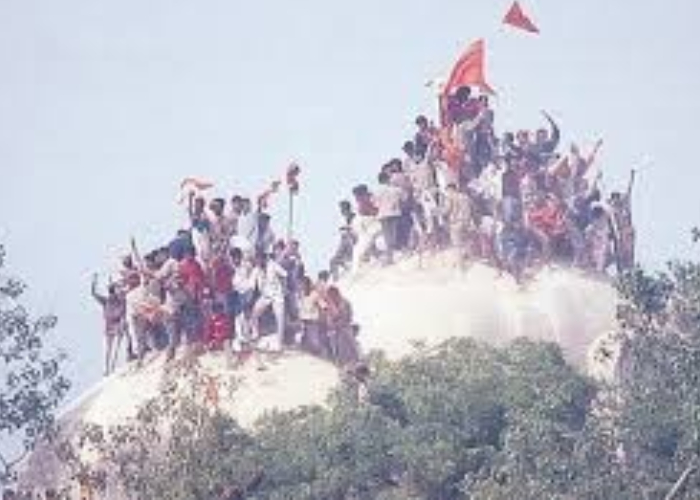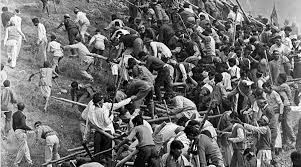
(On October 16, 2019, the hearing in the Supreme Court on the legal battle about the ownership of the land on which Babri Masjid was constructed concluded. Verdict has to come by November 17 because the sitting Chief Justice of India who headed the Bench will retire on that date.
There is one more legal battle still going on. A criminal case against L. K. Adwani, BJP stalwart and a former Deputy Prime of India, and several others allegedly responsible for the demolition of the Babri Masjid on December 6, 1992, is still pending.
It is time to recall what actually happened on that day. I had written this article originally in February 2018.
The relevance of the article is that had the masjid not been demolished, the dispute between Hindus and Muslims over the site would have continued endlessly. It is unthinkable that High Court or Supreme Court would have entertained a petition to demolish Babri Masjid for the construction of a Ram Temple.)


(Photographs downloaded from internet. No one in the crowd is seen carrying weapons or tools to damage the structure.)
I got the eyewitness account of the demolition of the Babri Masjid from none other than my elder brother Shri Nandji Sahay – about 17 years elder to me – who was present at the sight.
My elder brother had joined the Rashtriya Swayamsevak Sangh (RSS) sometime in late 1941 or early 1942 when he was a college student at Patna. He was arrested twice during the ‘Quit India’ movement in 1942. He remained an active member of the RSS as well as the BJP till his health permitted him. He died of old age in November 2012.
As an active member of the RSS, he was in charge of a contingent of karsevaks who went from Patna (capital of Bihar) to Ayodhya to participate in the movement for Ram Mandir a couple of days before December 6, 1992.
For months, as part of preparations for building the Ram Mandir, the karsevaks in different parts of the country had been making bricks with “Shri Ram” (in Hindi) engraved on each brick. At Patna, our joint house was the site where such bricks brought from several parts of Bihar were kept to be carried to Ayodhya.
As my elder brother told me, it was supposed to be a peaceful rally at Ayodhya.
On that fateful day, December 6, 1992, a large crowd of karsevaks (about 2 lakh, according to the BBC) assembled near the Babri Masjid. They were to be addressed by BJP and VHP leaders including L. K. Advani, Murli Manohar Joshi, Uma Bharati and others. To keep the crowd at a distance from the structure, the local administration had put up barricades. The police and members of the UP Provincial Armed Constabulary were regarding the barricades.
My brother told me that all the karsevaks who had assembled at the site were unarmed. The had no tool with which the Babri Masjid could be damaged.
By 11 o’clock, a part of the crowd started getting restless, pushing the barricades to reach near the structure. Those in the crowd who did not want to break the barricades were helpless when large number people started pushing their way. My brother was also pushed by the crowd and soon found his back hitting the lower part of the Babri Masjid. Some rowdy elements in the crowd started pelting stones at the structure. Meanwhile, some persons brought spades, pickaxe, mattocks, etc. from the nearby construction site. They started hitting the lower part of the structure with those tools but could not cause any damage. Quite a few of them decided to climb the structure. In the absence of any ladder, they used the persons standing near the structure as stepping stones. My brother discovered that two persons were standing on his shoulders, without the courtesy of taking his permission. Soon several human pyramids were formed and some people succeeded in reaching the top. There was no other way to go up. The top of the dome was so fragile that that sands when those standing there hit hard with their feet it collapsed like a castle of sands. The collapse of the upper parts encouraged part of the crowd to hit and demolish the middle and lower parts with the help of spades, pickaxe, mattocks, etc.
My brother told me that finding the crowd indulging in destruction, L. K. Advani and others started requesting them to climb down without causing any damage to the structure but those enthusiastic people ignored the appeals, not an unnatural behaviour of an unruly crowd.
Later, along with large number of karsevaks, my brother was also arrested. He was brought to Banares jail (constructed in 1854). Though I was worried about him, I had absolutely no means of communication with him. Realising that I must be worried, he sent me a letter from the jail in which he had written that ‘guardians’ had kept him in safe custody in Banaras. I could guess that he was in Banaras jail. Later, along with others arrested he too was released.
I met my brother a few months after his release from the jail when he narrated his eyewitness account and what he had suffered.
In reply to my specific query whether he had any inkling of any plan to demolish the building, his categorical reply was “NO”. In fact, he told me, he had asked many other members of the RSS who like him had led contingents of karsevaks from different parts of the country but none had any inkling. He told me that had there been any such ‘plan’, at least some of them could have an idea of that.
When I told him that there must be some fellows who had a secret plan, he told me that it was quite possible that some people belonging to non-RSS outfits had planned to do something sensational. He further told me that ‘when a large crowd assembles anywhere, there are always some rowdy elements bent upon doing some mischief.’ He admitted that some rowdy elements in the RSS might have desired to demolish the structure even though they had no permission to do so. Such elements could not be identified in advance. They started pelting stones and then hitting the lower part of the structure with construction tools which were available at some distance. Those tools had not been brought by the karsevaks with the bricks but were collected from nearby construction sites.
According to my brother, the main reason why the Babri Masjid could be demolished so easily was the very fragile construction at the top of the structure. Had the top been as strong as the lower parts of the structure, it could not have been demolished, in any case not with the tools the rowdy elements had.
I being at Delhi working in Government of India and my brother being stationed at Patna, we could meet only occasionally. In one of the subsequent meetings, I requested him to write down what he had seen and suffered. He promised but could not. Despite very good command over English as well as Hindi, he did not have any passion for writing. He kept on postponing the idea. As he grew older, his eyesight deteriorated and was almost blind for a couple of years before his death.
I must point out that I was never a member of the RSS or BJP. I have never been a great admirer of either. During my student days I was a Marxist. For some time I was member of the Communist Party of India. Out of my mistaken admiration for the Soviet Union, I did one year course in the Russian language. However, the unbridgeable gap between my brother’s political views and mine did not affect our was brotherly relationship. He never advised me to change my political views. On the contrary, I got maximum support from him in my studies and in preparations for the civil service.
I am convinced that the claim that the RSS had hatched a conspiracy to demolish the structure called Babri Masjid is as irrational and baseless as blaming the RSS for the assassination of Mahatma Gandhi. In 1948, the Nehru government considered it politically expedient to put the RSS in dock and win the sympathy of the minority community. Post-demolition of the Babri Masjid, the Congress and other self-styled secular readers have found it politically expedient to cook up conspiracy theory to divide and rule. The Jehadis and politicians of Pakistan are using Kashmir for their political survival. In India, the secularists think that blaming the RSS (the world’s largest non-political organisation), the BJP and now Narendra Modi for everything they do not like, is the easiest way to win over the minority community.
Devendra Narain
February 08, 2018
PS
Comments of two senior officers of Uttar Pradesh, the Indian state in which Ayodhya is located, in a Facebook group where I gave a link to the post.
A retired IP officer: Me who was present fully endorse your brother’s views. None told us about any conspiracy to demolish structure Turning point in our history
A retired IAS officer: I went there in 1985 with the then CM, Vir Bahadur Singh after the temple had been opened for Darshan by court orders and my reaction about the strructure was the same – too fragile and could fall easily.










Leave a Reply